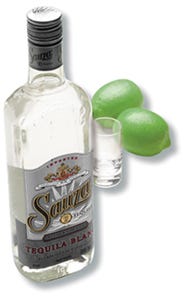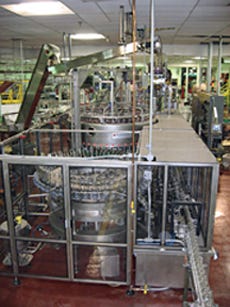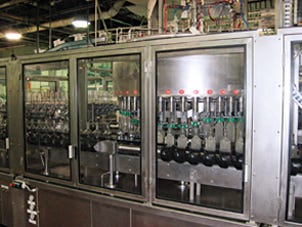In 2005, Jim Beam Brands Co. bought half of Allied Domeq from Pernod Ricard, and last year it installed a new line at its Frankfort, KY, plant to run Sauza tequila, which was part of the Allied Domeq acquisition. The Frankfort plant has eight bottling lines that run 300 stock-keeping units and last year produced 5.7 million cases of product.
The key to the new tequila line, which has a rate of 300 bottles/min, is a new Fowler/Perrier/Zalkin MATS 49/49/10 rinser/filler/capper tribloc, which was assembled by Fowler Products Co. (www.fowlerproducts.com). Fowler is the exclusive representative for Perrier and Zalkin in the U.S., and essentially “Americanizes” the equipment. This includes the complete electrical and control systems, including programmable logic controllers and human/machine interfaces from Rockwell Automation (www.rockwellautomation.com).
“We're basically partnering with Fowler on this line,” says corporate packaging engineer Robert Land. “We've used Zalkin cappers, which are represented in the U.S. by Fowler, for years, and we now have twenty-two Zalkin cappers at Jim Beam. We had bought a Perrier rinser in 2006, and Perrier visited us at that time and asked us what we would like to see in a filler. They then developed a filler specifically for liquor. We are very concerned about chipping the neck finish when the lift plates on fillers push the bottles up against the fill valves. Perrier uses grippers that transport the bottles by the neck, and this has eliminated this potential problem. The grippers can also handle different size bottles without requiring changeparts, which reduces costs and changeover times.
“Another feature we really like on this filler is the ability to adjust the fill height in the bottles without stopping the machine. Any time you stop a filler for any reason, you're asking for problems, and this lets us make adjustments on-the-fly, while the filler is running. We also like the automated clean-in-place system. If we are only making a minor flavor change in the products we're running, we can select a quick clean that only takes a short time. On the other hand, at the end of a run or for a major product change, we can select a complete cleaning and sanitizing procedure.
“The rinser/filler/capper has run very well, and we've been very impressed with it. And service from Fowler has been excellent. This Fowler/Perrier/Zalkin rinser/filler/capper will certainly be at the top our list when we buy more equipment.” The new tequila line has mostly new equipment, although it does include an existing case unloader and case packer and a rebuilt labeler. During PD's visit, the line was running 1-L bottles of Sauza Tequila Blanco. The operation starts with the receipt of empty bottles, which are supplied by O-I (www.O-I.com), packed upside-down in reshipper cases. Workers place the cases on a conveyor feeding the uncaser, which uses belts to grip the sides of the cases and carry them upward at an angle. This lifts the cases off of the bottles, which remain standing on the takeaway conveyor. The bottles are fed single file and conveyed to a new Dynac Model 6400 three-level bottle accumulator from Hartness Intl., Inc. (www.hartness.com) that provides first-in/first-out sequencing and has a capacity of 380 bottles. The system incorporates Hartness' unique “spider” bottle-transfer mechanism, which moves up and down the dual spiral conveyors to transfer bottles from infeed to outfeed conveyors.
After the accumulator, bottles are conveyed to the new rinser/filler/capper tribloc. The tribloc configuration enhances bottle handling, shortens the time the product is exposed to air and reduces floor space requirements. Another advantage is that all three machines have a common drive, control cabinet and operator interface.

A new rinser/filler/capper tribloc runs 300 bottles of liquor/min.The rinser and filler transport bottles by grippers beneath the neck, which minimizes chipping. In the 10-head capper, individual sealing heads descend onto the bottles with a 200-lb top load force to seal the caps onto the tops of the bottles.
The tribloc is housed in an enclosure that includes a top cover over the front tables of the rinser and filler to maximize hygienic design. The empty bottles enter the 49-station rotary rinser, where a patented gripping system picks them up by the neck. As the turret rotates, the bottles are inverted over individual nozzles that spray tequila (or whatever product will later be filled) up into them. To maximize the cleaning efficiency, a solid column of tequila is sprayed with enough velocity to strike the bottoms of the bottles and cascade down the interior walls. The tequila used for rinsing is collected, thoroughly filtered and recirculated through the rinser system. The entire rinsing fluid circuit is enclosed to minimize proof losses in the tequila. As the bottles are turned back upright after the tequila has drained, they pass over a suction device that removes any hanging drops remaining on the neck finish. The bottles exit the machine through a starwheel that delivers them to the infeed screw of the filler.
Next, the bottles pass around a starwheel into the 49-valve vacuum-gravity filler, which also uses grippers to transport the bottles by the neck. As the turret rotates, the grippers first center and then lift the bottles against spring-loaded valves, and the tequila is filled. During filling, a light vacuum draws the air from the bottles allowing the tequila to enter by gravity and fill the bottles to the proper level. In this laminar flow operation, spreaders at the outlet of the valves gently disperse the product against the walls of the bottles to minimize foaming and air incorporation. To ensure a uniform fill level, product is slightly overfilled, so at the end of the fill cycle, the cam-controlled bottle gripper lowers the bottle off of the valve weal and removes the excess by vacuum The bottles are then lowered, released from the grippers and discharged from the filler through a starwheel into the infeed screw that transports them to the capper.
The rinser/filler includes automated clean-in-place systems that can provide both quick and complete machine cleaning and/or sanitizing as required.
A starwheel meters the bottles into the 10-head capper, which applies aluminum, roll-on pilfer-proof (ROPP) caps. The caps, which are supplied by Alcan Packaging (www.alcanpackaging.com), arrive in corrugated boxes that are dumped into a floor hopper outside of the enclosure. A flighted, inclined conveyor transports them up into a rotary sorter that orients the caps and delivers them down a chute to a point directly above the starwheel, where the bottles entering the capper pick them off. In the capper, individual sealing heads descend onto the bottles with a 200-lb top load force to seal the caps onto the tops of the bottles. Thread rollers then form the caps into the bottle threads, after which tucking rollers form a tamper-evident seal that includes perforations.

During filling, a light vacuum draws the air from the bottles allowing the tequila to enter by gravity and fill the bottles to the proper level.
As mentioned previously, the rinser/filler/capper incorporates a single control system and HMI that communicates with all three machines. Operating parameters for different bottles can be stored in memory and recalled at the touch of a button. This system also allows the fill height to be adjusted while the machine is in operation.
The capped bottles are conveyed to another new Hartness Dynac Model 6400 accumulator and then travel past a new Model Lasetec II laser printer from Industrial Dynamics Co., Ltd. (www.filtec.com) that applies a 15-character code to the bottom of the bottle. The bottles are then conveyed to a rebuilt Solomatic 20-station, cold-glue labeler from Krones, Inc. (www.kronesusa.com) . A feedscrew separates the bottles to the proper spacing and meters them into the infeed star, which, in turn, places them onto individual bottle plates as the unit rotates. A centering bell descends to hold the bottle in place as the label is applied. The labels, which are supplied by Fort Dearborn Co. (www.fortdearborn.com), are placed in label magazines, and fingers pick the labels out of the magazines, wipe them across glue stations, and apply them to the bottles. Brushes then complete the label application by wiping the labels as the bottles rotate.
The bottles exit the labeler through a starwheel, and a Krones Check Mat inspection system checks the bottles to ensure the presence of the label. If a label is missing or misplaced, the bottle is rejected. After the Check Mat, the bottles are separated into multiple lanes and, in order to provide accumulation capacity, travel through a long S-shaped section of conveyor before entering an existing case packer that was transferred from another line. “We've been standardizing on Model 939 Versatron case packers from Standard-Knapp, Inc. (www.standard-knapp.com ) in all of our plants,” says Land, “but we ran a little over budget on this project, so we installed a case packer from an old line. We've got the Versatron in next year's budget.”
More information is available: |
Alcan Packaging, 773/399-8000. www.alcanpackaging.com. |
Fort Dearborn Co., 847/357-9500 www.fortdearborn.com. |
Fowler Products Co., 706/549-3300. www.fowlerproducts.com. |
Hartness Intl, Inc., 864/297-1200. www.hartness.com. |
Industrial Dynamics Co., Ltd., 310/325-5633. www.filtec.com |
Krones, Inc., 414/409-4000. www.kronesusa.com. |
O-I, 567/336-1434. www.o-i.com. |
Rockwell Automation, 414/382-2000. www.rockwellautomation.com. |
Standard-Knapp, Inc., 860/342-1100. www.standard-knapp.com. |
About the Author(s)
You May Also Like


